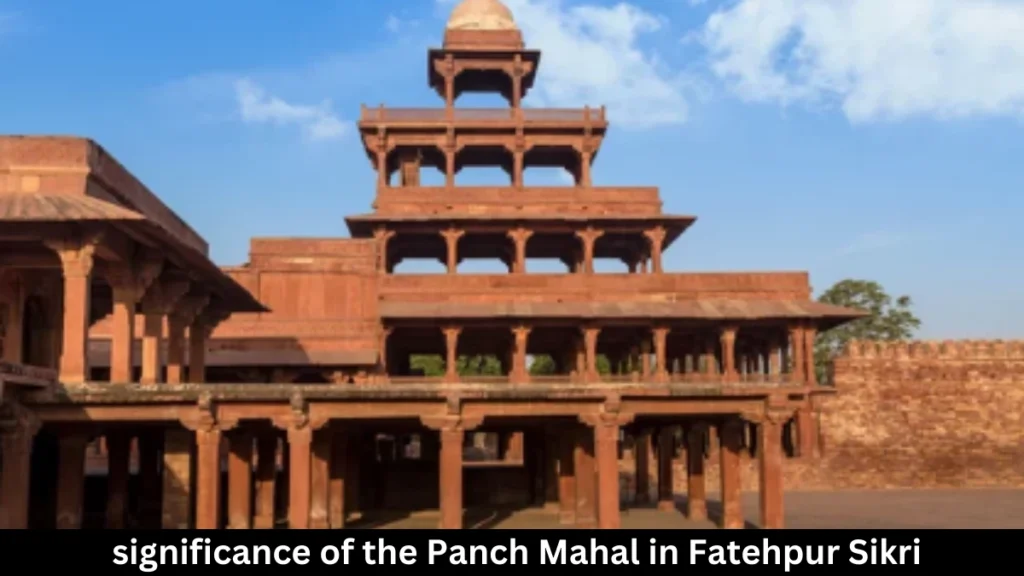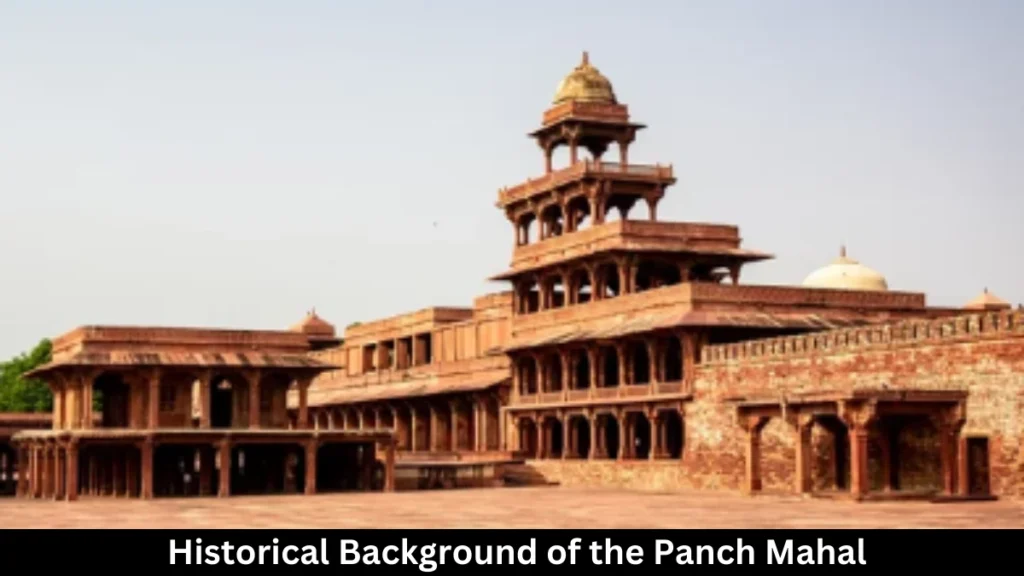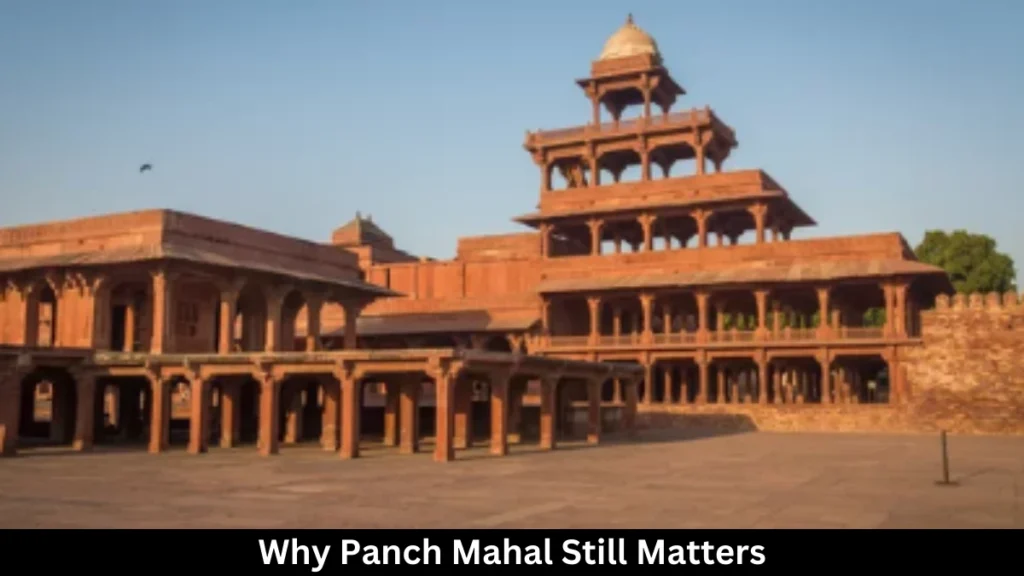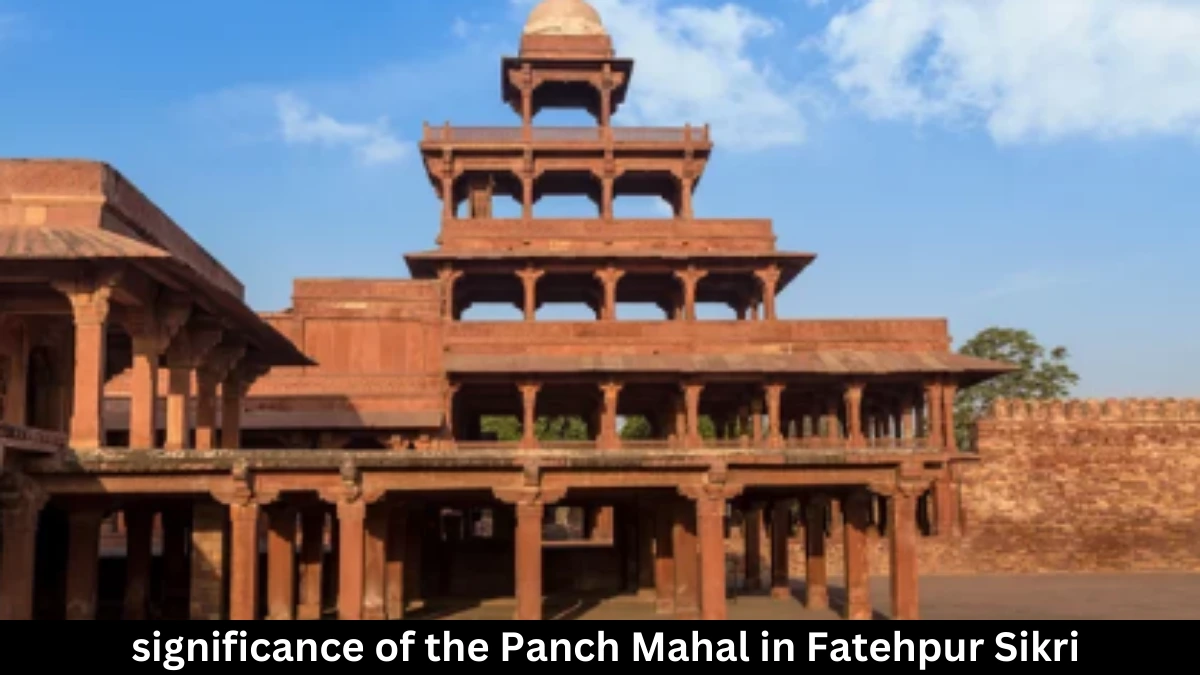Learn about the history, architecture, and significance of the Panch Mahal in Fatehpur Sikri, one of Akbar’s most iconic Mughal structures.
What is the significance of the Panch Mahal in Fatehpur Sikri?

Introduction to the Panch Mahal
Unlike the bombastic pride that is often embedded in the imperial Mughal architecture, Panch Mahal was conceived to incorporate porosity as its core. Featuring more than 170 of the filigree-cut columns placed at a remove from all but a few walls, the structure breathes — as if in the presence of zephyrs, openness and thought. Located near the Zenana or the women’s section, it seems to have been a retreat for the queens or royal ladies, a kind of a nature-museum of art and meditation.
This architectural wonder, though not purely a showpiece. It’s a cross-fertilizing whisper — a wrapping of Persian refinement with native Indian handiwork. The Panch Mahal still bewitches scholars, artists and dreamers with its lattice of light and air, a testimony to Akbar’s diverse influences.
Historical Background of the Panch Mahal

Built in the 1570s, when Fatehpur Sikri was the capital of Akbar, the Panch Mahal is a monument to the emperor’s eclectic approach to faith. This whole city was a homage to the mystic saint Salim Chishti, whose prediction Akbar believed had given him an heir.
Read This Also: What Are Some Interesting Facts About Fatehpur Sikri’s History?
Unlike bulwarks of conquest or chambers of policy, this fragile citadel was built for rest — a ballad to tranquillity. It takes cues from the blueprints of Buddhist monasteries, perhaps as an artistic byproduct of Akbar’s conversations with monks, theologians and freethinkers. There is nothing coincidental about this; it jibes completely with his fundamental philosophy of Sulh-e-Kul – universal peace.
Whereas Diwan-i-Khas rattles with authority, whereas Buland Darwaza boasts triumphal, Panch Mahal is mute. Instead, it murmurs peace. It was next to the harem, and had echoes of music and muffled voices, drowsy evenings, and days made gracious by a sun softened for the sex of birds.
Architectural Whimsy: An Unconventional Design
In architectural terms, the Panch Mahal is a silent revolt. Refusing the ornate thickets so characteristic of ‘Mughal’ façades, this building opts for a vertical sense of lightness. Five cascading tiers rise to a point that is loomed over by the deep red sandstone and is set ablaze at dusk, like an ember in the sky.
That featherweight colossus is upheld by 176 columns — each no less an art than it is part of the whole. Not two are alike. Their contrasting motifs — some floriated, some geometric — whisper of different hands that formed them. A cosmopolitan cohort of craftsmen probably contributed, leaving regional packed signatures in stone.
Jaalis — or perforated stone screens — contribute an ethereal beauty. They are not decorative alone: They’re changing and shadowing; and allow the women of the court to see the world without having to be seen. The building inhales in rhythms — it’s open and then it’s protected; it’s naked yet deep.
Ascension in Architecture: A Tier-by-Tier Chronicle
The various levels of the Panch Mahal reveal their own mood, function and significance instead:
First Floor: Here the base is broadened by a lifting of the ground; some 84 stout pillars come into view — were these once the venue for casual assemblies, or performances of a pastoral nature?
Second Floor: (the right is not quite centered above the left) A room which could contain small indoor instrumental recitals or courtly balls under moonlit skies.
Third & Fourth Floors: More intimate, with a cozy feel; these levels are for whispered confidences or private thoughts.
Fifth Floor: Capped with an odd little chhatri of its own, this tiny summit provides a 360-degree meeting with the cityscape — a whisper of a pulpit, for emperors and empresses looking out over and nodding toward their world.
This vertical tapering is not merely practical: It’s allegorical — a poetic metaphor for transcendence, lifting the viewer from the earthbound to the otherworldly.
Use of Pillars and Jaalis
The pillars of the Panch Mahal are more than just supports; they’re stories in stone. Each one, as individual as a snowflake, partners strength and decoration. They are no walls but enticements — to movement, to conversation, to sky.
The jaalis are visual lullabies — their arabesques throwing kaleidoscopic shadows that play with the sunshine. They conferred seclusion without penetrability, privacy without imprisonment.
Cultural and Symbolic Importance
For the Panch Mahal it’s not just in the architecture dictionary. By its very nature, it is an ideology cast in red stone. [“Akbarnama”] With interfaith motifs, a structure designed for transparency and rhythmic openness, the building serves as a metaphor for Akbar’s visionary empire — one that was not held together by force, but through dialogue and coexistence.
The asymmetricality of the building becomes a manifesto telling us that walls, whether we mean the physical ones or ideological ones, are only obscuring the perception. For the cloistered women of the court, it was a rare moment of autonomy — a glance beyond the veil, an unfiltered breath of nature.
Despite its simplicity, today the panch mahal is a hymn to conscious design and indictment of excess. It’s a relic, yes — but, as well, a manifesto.
Preservation and Tourist Value Today
Now it stands amid the murmur of tourists and the watchful gaze of conservationists, while the Panch Mahal features on the UNESCO WHS tapestry. Erosion and the relentless march of time slowly gnaw at its finer details, but the Archaeological Survey of India’s conservation efforts endeavour to protect its repose.
Less circus like, more balletic, its visitors — lured not by flamboyance but finesse — are often stilled, hushed by its grace. Some modern additions, including guided tours, multilingual signage and gentle restorations, have made the experience more enveloping while not encroaching on the sacred silence that envelops the site.
In an age when monuments would much rather scream, the Panch Mahal still whispers — and therein lies its power.
Conclusion: Why Panch Mahal Still Matters

It’s to speak of Panch Mahal — a long time ago to be sure, but a concept that somehow still feels shockingly contemporary. It’s where philosophy becomes flesh, where elegance arrives in air and light. Its architecture is liberation in song: liberation from the bounds and weights, even the symbolism, of traditional institutions and monuments, in order to make room for something liberated from the restraints of those forms and symbols.
Akbar, the emperor-alchemist of concord, left behind not a fortress, but a sanctuary — and it endures, not just in history books, but in the hearts of those who chance upon its resplendent silence.
For the architect, it presents the blueprints of enduring design. It is a living chronicle for the historian. It’s a refuge for the wanderer. In every column, every breeze that whispers through its jaalis, the Panch Mahal bids us to stop — and be.

My name is Radha Sharma and I live in Agra. I have started this first blog of my life Agrafast.in to make my future in blogging by watching videos of many big bloggers through the internet for a long time.

